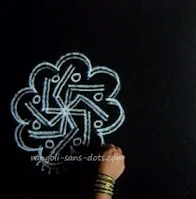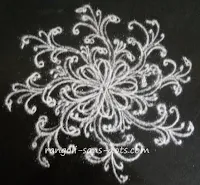rangoli designs without dots
White rangoli - double line kolam
Most Indians believe drawing of rangolis in homes is auspicious.
Method: Mix rice flour with rangoli powder (50gm of rangoli powder 5gm of rice flour approx). Change the proportion according to the flow of the powder.
Take this mixture, using the thumb, index finger and middle finger , let it flow between the index and middle finger to get two parallel lines. It comes with practice.
Without chukki rangoli with 2 lines
| Rangoli no. 1 The two images below show how the rangoli at the top evolves through parallel lines
Two more muggulu without chukkalu with 2 lines
Star based double stroke kolam
|
If required few colours can be added between the parallel lines. But that will be some other day some other time. . The central floral design is drawn with parallel lines and the design is expanded with just parallel lines to form floral or creeper like designs .
Plain rangolis for all occasions, though only a few have been posted are quite popular here. However, these two above are among my most favourite designs that I draw with various permutations and combinations possible with the patterns I have in my mind. If you would have noticed there can be at least seven to eight patterns from the central design to the outermost in a simple pattern like the one above. When they are combined in different orders we get many designs.
This is the first post in Rangoli-sans-dots. More plain rangolis are in plain free hand rangoli , free hand plain rangolis and Rangoli literally means rows of colours and hence they are expected to be colourful. However we cannot totally avoid plain designs (without colour) and hence I will post only a few. Rangoli-sans-dots has arrived. It was born on an auspicious day. It had been there in my mind for a long time. The form and nature could not be decided. I am thankful to my family members for making it a reality, for encouraging me to go ahead, for motivating me and for their inputs and help.
Rangoli is called kolam in Tamil Nadu so I was wondering whether to name it kolam-sans-dots or rangoli-sans-dots. Finally I settled for this name. Sans means without and so rangoli-sans-dots literally means rangoli without dots. These types of designs also called free hand rangoli are my strength ( or weakness ) . So I will attempt to upload rangoli sans dots initially.Plain rangolis for all occasions, though only a few have been posted are quite popular here. However, these two above are among my most favourite designs that I draw with various permutations and combinations possible with the patterns I have in my mind. If you would have noticed there can be at least seven to eight patterns from the central design to the outermost in a simple pattern like the one above. When they are combined in different orders we get many designs.
This is the first post in Rangoli-sans-dots. More plain rangolis are in plain free hand rangoli , free hand plain rangolis and Rangoli literally means rows of colours and hence they are expected to be colourful. However we cannot totally avoid plain designs (without colour) and hence I will post only a few. Rangoli-sans-dots has arrived. It was born on an auspicious day. It had been there in my mind for a long time. The form and nature could not be decided. I am thankful to my family members for making it a reality, for encouraging me to go ahead, for motivating me and for their inputs and help.
Rang in rangoli means colours. However kolam in Tamil Nadu that is drawn daily is usually plain with white lines. So it will be rangoli without dots and without colours for some time. Rangoli filled with colours are sought after for festivals like Diwali, Navratri and Margazhi ( a Tamil month between December 15 and January 15 ). During Margazhi we have hundreds of kolam drawn early in the morning at the doorways and it is a festive atmosphere. So I cannot afford to avoid rangoli or kolam with colours filled in them. I will venture into more colourful designs
I am also comfortable with rangoli with dots. So designs with dot grids of various sizes from simple to medium and a few big ones can be expected. Actually I am planning to draw all the designs with rangoli (powder ) and fill them with colours so the bigger the rangoli the longer it is going to take. (Giving me some allowance for the time constraints I have ) I would like to go for more small and medium versions (less than 15 dots ). Drawing a big rangoli with dots or free hand and filling the gaps or patterns will take quite some time - between 1 and 2 hours. Since I am planning to do it the traditional way - drawing with hand and filling the designs with hand - bigger and intricate designs require time to complete. After completing a rangoli design giving the final and finishing touches also takes up some time. So kindly bear with if you find designs smaller than you would have expected.
Small rangoli, rangoli for beginners, for children, for festivals will be covered. Parallel line or double line rangoli is also among the methods of drawing these designs I am familiar with. So expect a few of these type. Incidentally, the first post has only parallel line rangoli. Many of them will be free hand with an occasional one with dots.
I also plan to have a few craft ideas and decorations some of them based on rangoli designs. I gave a deep thought whether I should post recipes too. There are many recipe websites so I am not sure I will be able to add anything new. However when I post some ideas for festivals I would like to add some recipe ideas and photos of my own preparations relevant to the festivals and an occasional post on simple veg recipes. Adding recipes relevant to the festivals may help in value addition for Rangoli-sans-dots.
So here it is. I will stick to mainly rangoli with relevant and useful inputs based on the festivals and occasions I discuss.
I am not familiar with blogging. However I will learn from my (in) experience. So rangoli-sans-dots will grow like a free hand rangoli that grows and expands from a small pattern at the centre. As it grows so will my experience and my share of mistakes (in blogging ) will come down . As it grows I will definitely have more ideas to share, more images to draw, more information to give, in a better way.
Kolam is also drawn in Puja rooms for which designs including those that are there for decades ( like Hridaya kamalam, Aishwarya kolam ) are drawn.
Turmeric powder is considered auspicious and so for some religious functions it is mixed with rangoli powder and the rangoli design is drawn. In fact we find that the entrance of marriage halls in some places are decorated with padi kolam designs (traditional rangoli ) drawn with turmeric powder mixed to give a yellow design. Initially drawn with rice flour or kolam powder as it is called the rangoli or kolam designs have evolved with many new ideas having come into play. Now we have floating rangoli, kundan rangoli designs, rangoli with salt, coloured rice and also rangoli from collage. Some also do it as a hobby creating new designs on paper. Presently, we also see a lot of rangoli competitions based on various themes where rangoli designs are portraits, landscapes. Themes are based on Independence Day, Women's Day, Mothers Day, Fathers Day, Olympics and so on and consequently designs are drawn to match the theme. The basic method is the same, use rangoli (a sort of white rock powder ) in white and many other colours but instead of patterns and designs we have portraits.
Rangoli.
Rangoli is a traditional design usually drawn on the floor. It is drawn for special occasions and festivals like Diwali. Rangoli usually means free hand rangoli. More free hand designs than rangoli with dots are drawn. Rangoli literally means rows of colours.
So plain rangoli does not exist. However I am using this term in Rangoli-sans-dots for better classification and understanding. Rangoli is called by various names in different parts of India. i.e. West Bengal, Maharastra, UP, Gujarat, Rajasthan, Andhra Pradesh etc. However the basic idea is the same. Drawing simple to intricate patterns on the floor using colours to complete the design or drawing just plain and white.
So plain rangoli does not exist. However I am using this term in Rangoli-sans-dots for better classification and understanding. Rangoli is called by various names in different parts of India. i.e. West Bengal, Maharastra, UP, Gujarat, Rajasthan, Andhra Pradesh etc. However the basic idea is the same. Drawing simple to intricate patterns on the floor using colours to complete the design or drawing just plain and white.
Kolam
It is a traditional design drawn on the floor in Tamil Nadu where I live. Kolam is usually drawn with dots except free hand designs and padi kolams Kolams are usually drawn plain, with white rangoli . Traditional designs are called padi kolams and are used for auspicious occasions. These kolams are surrounded by a kaavi border. Kolam with dots called sikku kolam. Sikku literally means knots and true the name these can tie us up in knots. Drawing these kolams is very difficult , particularly advanced ones. Trying to understand how it was drawn is more difficult.
The kolams drawn during Margazhi (the period between December 15 and January 15) are very large, beautiful and colourful. This is an art that is drawn invariably every day at the thresholds or the drawing rooms or puja rooms of houses.
The kolams drawn during Margazhi (the period between December 15 and January 15) are very large, beautiful and colourful. This is an art that is drawn invariably every day at the thresholds or the drawing rooms or puja rooms of houses.


